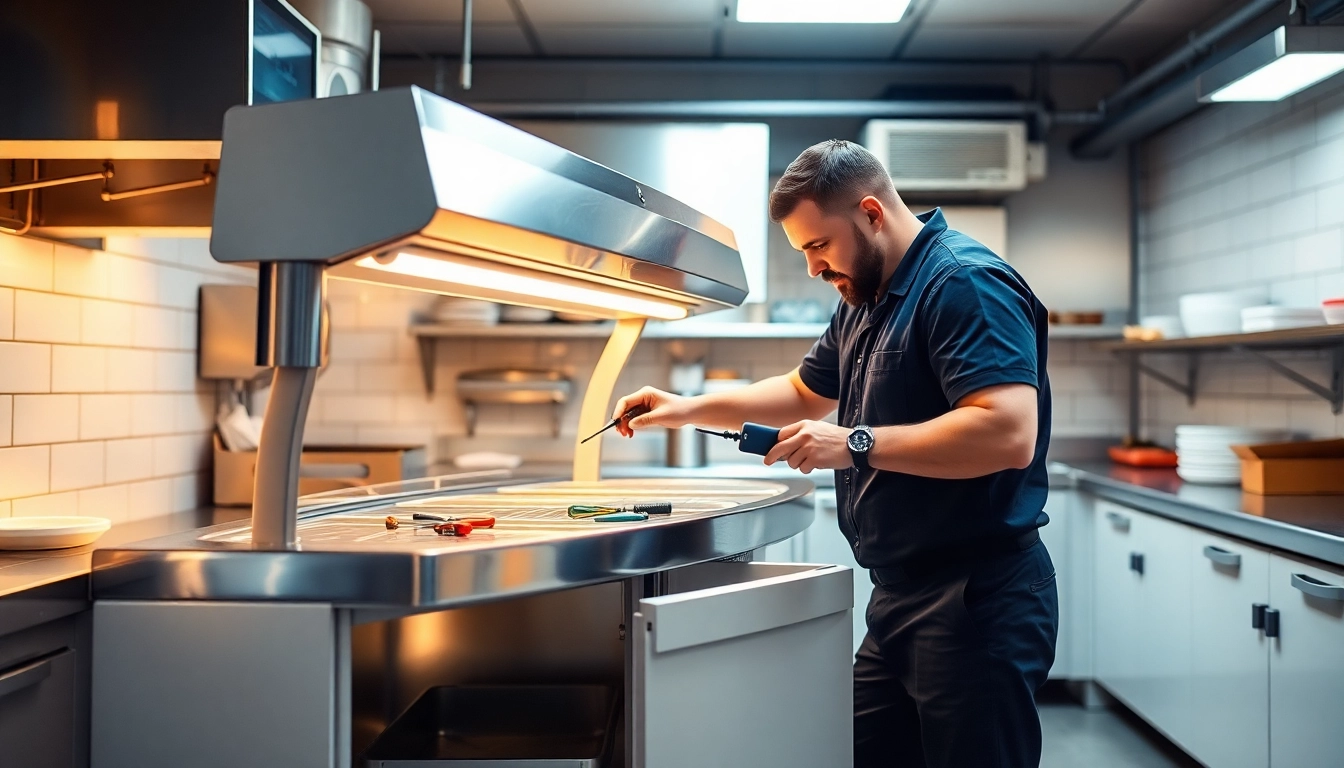Understanding Prep Table Repair Basics
In any commercial kitchen, a prep table is crucial for efficient workflows, allowing chefs to prepare and assemble dishes swiftly. However, like any kitchen equipment, these tables can experience wear and tear over time, requiring timely prep table repair. Understanding the basics of these repairs not only aids in extending the life of the table but also enhances kitchen performance.
What is a Prep Table?
A prep table is an essential piece of restaurant equipment designed for food preparation. Typically featuring refrigerated compartments, these tables provide a space for chefs to manage ingredients efficiently. They come in various sizes and functionalities, including salad, pizza, and sandwich prep tables, ensuring that specific needs are met depending on the kitchen setup.
Modern prep tables often include cutting boards, refrigerated drawers for perishable items, and shelving for additional storage. They are built to keep food items at safe temperatures, which is critical in preventing foodborne illnesses and maintaining food quality.
Common Issues Leading to Repairs
Despite their essential role, prep tables commonly face several issues that may necessitate repairs:
- Thermostat Failures: Inconsistent temperatures can lead to spoilage of ingredients.
- Poor Door Seals: Damaged gaskets can compromise temperature control.
- Electrical Problems: Wiring issues may affect the functionality of refrigeration systems.
- Water Leaks: Condensation drainage failures can cause water pooling under the unit.
- Physical Damage: Scratches, dents, or rust that can arise from daily use.
The Importance of Regular Maintenance
Regular maintenance is critical for the longevity of prep tables. Schedule consistent checks to ensure all components are functioning correctly. This practice not only prevents major issues but also promotes a clean and safe working environment. An investment in preventative maintenance can lead to significant cost savings in the long run by reducing emergency repairs.
How to Identify Prep Table Problems
Signs Your Prep Table Needs Repair
Being aware of the signs indicating that your prep table might need repairs is essential. Here are some common indicators:
- Temperature Fluctuations: If the food isn’t staying at safe temperatures, the thermostat may be malfunctioning.
- Unusual Noises: Any continuous buzzing or hissing sounds could indicate a problem with the compressor or fan.
- Excessive Condensation: This might suggest that the door seals are worn or there’s a problem with the refrigerant.
- Inconsistent Power Supply: Flickering lights or poor performance can signify electrical issues.
Diagnostic Tools for Efficient Repairs
Utilizing the right diagnostic tools can streamline the repair process. Some essential tools include:
- Digital Thermometers: Useful for checking the internal temperatures of food storage areas.
- Multimeter: Vital for troubleshooting electrical issues and checking voltage and continuity.
- Leak Detectors: Helpful in identifying refrigerant leaks.
Recording and Analyzing Performance Issues
Keeping a log of performance issues can help in identifying patterns that lead to repairs. Detailed records of temperature readings, maintenance schedules, and repairs performed will provide a comprehensive view of the table’s operational performance over time. This data can help in prioritizing issues before they escalate, thus enhancing the efficiency of the repair process.
Step-by-Step Prep Table Repair Process
Essential Tools for Prep Table Repair
Preparing for repairs requires a set of standard tools that ensure successful troubleshooting and fixing. Here’s what you’ll need:
- Screwdrivers: Both flathead and Phillips for removing panels.
- Pliers: For gripping and manipulating wires and other components.
- Wrenches: Essential for tightening bolts or fittings.
- Sockets and Ratchets: Useful for greater torque when removing screws or bolts.
Repairing Common Issues: A Hands-On Guide
Addressing common issues can often be accomplished with a few straightforward steps. Here’s how to tackle several typical problems:
- Temperature Control Failure: Check the thermostat settings and replace the thermostat if necessary.
- Poor Door Seals: Inspect the gasket for wear. Replace it if it appears cracked or worn out.
- Cleaning Condensation Drain: Clear any clogs from the drain line using warm water or a mixture of vinegar and baking soda.
- Electrical Troubleshooting: Use a multimeter to check for continuity and replace faulty wiring or components.
Safety Precautions During Repairs
Safety should be your top priority during any repairs. Follow these precautions:
- Always disconnect the power before attempting repairs.
- Wear safety glasses and gloves when handling tools and components.
- If working with refrigerants, ensure you are using proper equipment and procedures to handle it safely.
- Be aware of sharp edges and moving parts, and take appropriate precautions.
Preventive Measures for Longevity
Routine Inspection Checklist
Implementing a routine inspection checklist can help in maintaining the efficiency of prep tables. Suggested checks might include:
- Inspecting door seals and hinges for proper function.
- Monitoring temperature settings weekly.
- Cleaning the condenser coils to improve efficiency.
- Checking for any unusual noises or vibrations during operation.
Cleaning and Sanitizing to Avoid Repairs
Cleaning and sanitizing the prep table not only maintains hygiene but also delays repair needs. Follow these guidelines:
- Remove all food items and debris.
- Use non-abrasive cleaners to wipe down surfaces.
- Sanitize with a food-safe solution and allow it to air dry before placing items back.
- Regularly schedule deep cleanings to maintain the integrity of the equipment.
Best Practices for Proper Usage
Using the prep table correctly can prevent many common issues. Consider the following best practices:
- Avoid overloading the table beyond its capacity.
- Keep the surface organized and clear to allow proper airflow around refrigerated areas.
- Train staff on proper handling techniques to minimize physical damage.
When to Call for Professional Help
Identifying Complex Issues
While many issues can be swiftly resolved, certain complex problems often require a professional’s expertise:
- Compressor Failures: Replacing a compressor is intricate and requires specialized knowledge.
- Refrigerant Issues: Handling refrigerants should only be attempted by certified professionals.
- Extensive Electrical Problems: Malfunctions involving the main power supply necessitate expert assessment.
Choosing the Right Repair Service
Selecting an appropriate repair service can significantly impact the quality of the fix. Here are points to consider:
- Look for certified technicians with experience in commercial kitchen equipment.
- Check reviews and ratings from previous customers to gauge reliability.
- Ensure the service provides warranties on both parts and labor.
Cost Considerations and Service Agreements
Understanding the costs associated with repairs is essential for budgeting. Some factors affecting repair costs include:
- The nature of the repair (minor vs. major).
- Timeline for service (emergency repairs may incur higher costs).
- Location of the service provider and availability.
Consider negotiating service agreements that include regular maintenance to mitigate unforeseen repair costs.



